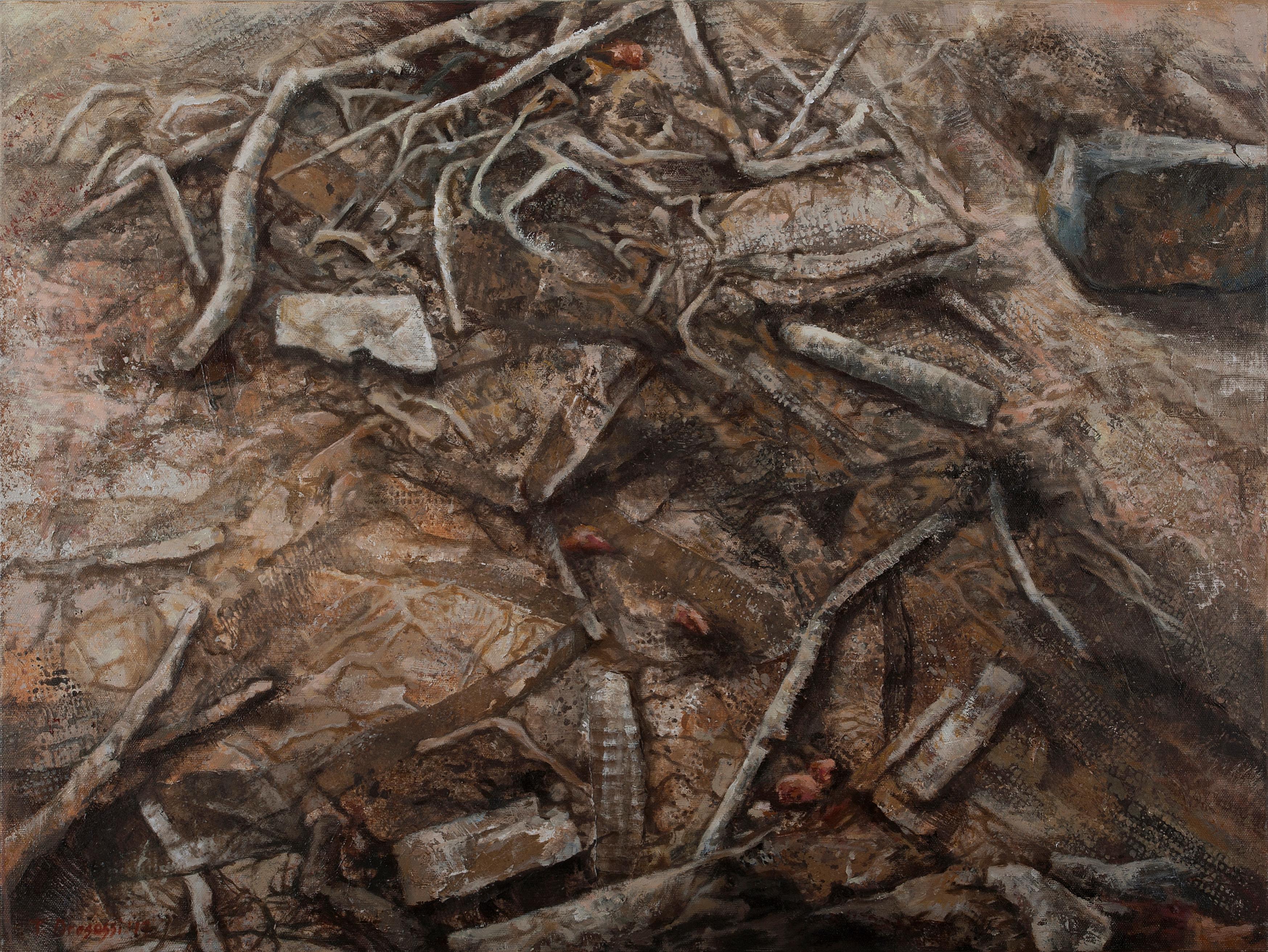
Randomly Cast About
Randomly Cast About
Tania Drogossi, in the unit of her works of painting presented here, undertakes the role of the narrator, and, at the same time that of one on a journey, as her gaze opens up a path among the low branches, sometimes crossing small clearings and sometimes shady spots, in order to trace out and pursue ancient pathways obliterated by time which make up her own artistic and wooded labyrinth.
In pictures of differing sizes, whose vehicle is canvas, the artist has depicted with linseed oil, acrylic paints, and mixed materials, the aspects and routes of a real, but at the same time, imaginary, woodland which Tania Drogossi reveals to us, usually through an imaginative variety of forms and a downward diagonal perspective. There is here a flexibility which in this painting is taken on by the folds and refoldings of the space, seen through the perspective of the 'eagle', as that was more widely known in the years of the Renaissance, that is, of an experiential perambulation, which takes place as a visualization as to happenings within and outside the story. This perspective, which surveys and at the same time looks downwards (the opposite to that of the 'frog') brings to the forefront the meaning of localism in relation to that of diachronicity - a relation which applies, by analogy, to background and surface, the earthly and transcendental level, as well as to the apparent - in a symbiotic co-existence and balanced contrast - with the things concealed which are to be found in the shadows of this real (in artistic terms), but at the same time notional, woodland.
The symptotic and asymptotic features in these works, together with the visible and the unseen, correspond to the dialogue which exists between the consciousness and the unconscious, individuality and collectivity, the past and the present, myth and history. Because it is certain that, Tania Drogossi, in employing the realistic style combined with the expressionistic gesture, and, in terms of color, a contrapuntal dialogue between the cool and warm 'highlights' of impressionism, is doing none other, in what is essentially her allegorical and symbolic language, than hydrating and vivifying the earthiness and fragility of the objects, which, defective, and themselves resisting decay, and sometimes left to their fate, challenge the passer-by like persistent questions. They attract, in other words, his momentary attention, by means of their discontinuities and the 'interceptions' which every one of their story scenarios has undergone in the course of time, as can be seen in the reality which nature here defines, as does the intercepted 'cohesion' which applies to the plot of each individual narrative.
Tree trunks and gray branches shape a strange three-dimensional 'alphabet' with hieroglyphics (if it is considered that we are looking at these 'objects' as forms), setting aside for the time being their meanings which are sought after and which they had at other times. In other places, again, they are reminiscent of syllables which trace out forgotten fragments and meanings, now worn away and coming, as it were, from that weaving of expectation of Penelope, with dried vegetation alongside and stones left to their solitude. Among them, one sees clods of earth, ashes, and cigarette butts, yellowing leaves, and some orphaned remnants from an earlier life or from a chance and fateful passing by of an individual, such as a dilapidated shoe, useless and discarded objects left to their fate, broken and forgotten, such as a small receptacle with rainwater in it. Suddenly, the gaze is hooked by a piece of rope, then pieces of wood and pebbles 'randomly cast about', to recall the words of Xenophon, make their appearance. And all these things, represented by the colors, and chiefly by means of the tonicities and the hidden joyful sorrow of the ochre, the washed out blue, the pink of dawn and of a stifled heartache, come in these works to meet the burnt umber of a resolution or the violet of a nostalgic evening, as well as of the reddish shades which, like daydreams long ago and indelible memories, interweave, like some lacework, their texture through the off-white tones and ashen semi-tones of absence.
[…]
To sum up, we would say that the complexities of this woodland environment, which frames the viewer in terms of theme. but also in terms of the exhibition, like fantasy aspects and routes of consciousness and the unconscious, are unified by means of an informally shaped labyrinth. By means of the discontinuities in time suggested by the leftovers of nature and of human action upon it, and of the random or fateful leaps which time and conjunctures manifest, perplexity is bridged in these works by the enigma, and the dramatic nature of the asymptote by a latent lyricism. Representationalism, by the aid of which a reflective re-examination of concepts is activated, having met up, in this instance, with the uncommitted negotiation of gestural abstraction, draws attention, in the end, to the cohabitation of past and present.
We discern, furthermore, mutability of the personal state into - with time - the impersonal, in the way in which, in any event. memories and impressions work - typical characteristics contained not only by our sell and the culture which we produce. but by nature itself as it surrounds us, and, as beings, constitutes us.
Athena SchinaHistorian of Art & Theory of Culture
